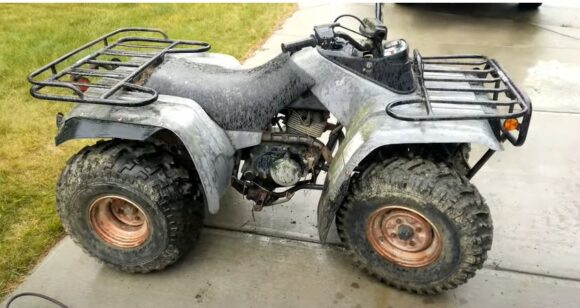Are you a proud owner of the Yamaha Moto 4? Then you know that it is a powerful and reliable ATV. But like all machines, even the best can experience problems.
If your Yamaha Moto 4 isn’t running as smoothly as it should be, don’t worry – there are some common issues that come up with this model of ATV and they have straightforward solutions!
In this article, we’ll take a look at the most common problems faced by owners of the Yamaha Moto 4, along with some helpful tips for fixing them quickly and easily.
Yamaha Moto 4 Common Problems

1. Starting Problem
If you own a Yamaha Moto 4, you know that starting it can be a real challenge.
You’ve tried everything – checking the spark plug, changing the oil and filter, but nothing seems to work. You’re frustrated and ready to give up on your beloved ATV.
Don’t despair! There is an answer – try cleaning or replacing your carburetor jets! This simple fix could solve all of your starting problems in no time at all.
With just a few tools and some elbow grease, you’ll have your Yamaha Moto 4 running like new again in no time!
2. Electrical Problems
Electrical problems are a common issue with Yamaha Moto 4s, and they can be caused by a variety of factors.
The most common electrical issues include short circuits, faulty wiring, bad connections, or corroded battery terminals.
Additionally, some older models may have a defective stator coil that could cause electrical problems.
To address these issues properly it’s important to diagnose the source of the problem and correct it accordingly.
This may involve tracing wires for continuity, replacing worn-out components, or cleaning corroded battery terminals.
Also, if the stator coil is at fault you will need to replace it with an aftermarket part that is compatible with your model of ATV.
Once all repairs are complete it is also important to check the voltage output of the charging system to ensure proper operation.
3. Not Firing
One of the most common issues with Yamaha Moto 4s is that they may not be firing correctly.
This problem can manifest itself in a few different ways, including an engine that won’t start, or one that runs erratically and unpredictably.
It could also be accompanied by a sputtering or misfiring sound coming from the cylinders.
This issue is typically caused by problems with the spark plugs or wiring harness, which doesn’t allow for enough current to reach the spark plug and ignite the fuel-air mixture needed for combustion.
Faulty spark plugs, particularly those that have become corroded or damaged, are often to blame for this issue.
A visual inspection of the spark plugs should be performed first; if they appear worn out, cracked or corroded then they should be replaced immediately with new ones.
If the plugs are in good condition but it still won’t fire up, then it’s worth checking all of the wiring harness connections and ensuring that everything has been secured properly and isn’t loose or frayed.
4. Transmission Problem
Are you having trouble with your Yamaha Moto 4 transmission? Is it shifting erratically or not at all?
Don’t worry – we’ve got you covered! Our team of expert mechanics has years of experience working on Yamaha Moto 4s and can quickly diagnose and repair any transmission issues that may arise. We’ll make sure your bike is back up and running in no time, so you can enjoy riding again without worrying about a faulty transmission.
We’ll make sure your bike is back up and running in no time, so you can enjoy riding again without worrying about a faulty transmission.
5. Shifting Problems
One of the more common issues experienced by Yamaha Moto 4 owners is shifting problems.
These issues can range from difficulty shifting gears to a slipping clutch, or even an inability to shift at all. In some cases, the problem may be as simple as a worn clutch cable or an issue with the shift lever assembly.
However, in other cases, more serious components such as the shift drum and gear forks may need to be serviced or replaced.
In order to accurately diagnose the cause of a shifting issue on a Yamaha Moto 4, it’s important to understand how the engine and transmission work together.
When shifting gears on the Moto 4, there are two separate mechanisms at work; first, power is transferred from the engine to the transmission via a chain drive system; second, once that power has made its way into the transmission it needs to travel through various components in order for it to reach its final destination (the gear you’re trying to engage).
If any part of this process is faulty or damaged then it can lead to difficulty in engaging desired gears.
6. Ignition Issues
Ignition issues can be a common problem with Yamaha Moto 4 ATVs.
The issue may manifest itself as a lack of power or misfiring of the engine, which can make it difficult to start. In some cases, the ATV may not start at all and will need troubleshooting.
The most common cause of ignition issues is a faulty spark plug. Spark plugs are essential for providing an electric spark that ignites the fuel in your engine, so if they are not functioning properly your engine will not run as expected.
If you suspect this is the case, it is best to replace the spark plug and see if this solves the issue.
Further, poorly maintained spark plugs can lead to pre-ignition and detonation which could damage your engine over time. Make sure you check your spark plugs regularly and replace them when necessary.
7. Oil Leakage
Oil leakage is a common problem with Yamaha Moto 4s that can be caused by a number of issues.
Oftentimes, the source of an oil leak is due to a loose or damaged drain plug, allowing oil to escape from the crankcase. More, worn-out seals and gaskets can also lead to leaks if they are not properly replaced when needed.
Finally, any cracks in the case itself can be another source of leakage.
The best solution for dealing with an oil leak is to have the bike serviced immediately and make sure that all necessary parts are replaced or tightened as needed.
Finally, if there appears to be any type of crack in the case itself then it needs to be attended to by a professional mechanic as soon as possible in order to avoid further damage and costly repairs down the line.
Conclusion
Yamaha Moto 4s are a popular and reliable ATV, but they’re not immune to problems. Some of the most common issues that owners experience include carburetor stalling, battery draining quickly, and engine misfiring.
Fortunately, these problems can usually be fixed with relative ease by replacing parts or resetting components.
It is important for Yamaha Moto 4 owners to stay on top of maintenance checks in order to keep their vehicles running smoothly over time.
Technical Specifications of Yamaha Moto 4 ATV:
| Specification | Details |
|---|---|
| Engine | 4-stroke, air-cooled |
| Displacement | 200cc |
| Transmission | 5-speed manual |
| Drivetrain | Chain |
| Fuel System | Carburetor |
| Front Suspension | Independent, double A-arm |
| Rear Suspension | Swingarm |
| Front Brakes | Dual hydraulic discs |
| Rear Brakes | Mechanical drum |
| Tires | Front: 22×7-10, Rear: 22×10-10 |
| Length | 71 inches |
| Width | 40 inches |
| Height | 42 inches |
| Wheelbase | 45 inches |
| Ground Clearance | 6 inches |
| Dry Weight | 350 lbs |
| Fuel Capacity | 2.6 gallons |
Pros and Cons of Yamaha Moto 4:
Pros:
- Durability: One of the main strengths of the Moto 4 was its durability. The ATV was built with sturdy materials, and many units have survived for decades with minimal maintenance.
- Ease of Use: Yamaha designed the Moto 4 with user-friendliness in mind, making it suitable for both beginners and experienced riders.
- Affordable Maintenance: Replacement parts for the Moto 4 are relatively inexpensive, especially when compared to the newer, more sophisticated ATVs. This made upkeep and repairs more affordable for owners.
- Good Traction: The Moto 4 had good traction on different terrains, making it suitable for a variety of uses including trail riding and light farm work.
- Compact Design: The design of the Moto 4 was more compact compared to some of its competitors, making it easier to maneuver and store.
Cons:
- Outdated Technology: Being a product of the 1980s, the Moto 4 lacks the technological advancements and features found in modern ATVs. This includes electronic fuel injection, advanced suspension systems, and digital instrumentation.
- Limited Power: Compared to modern ATVs, the Moto 4 has limited power. This can make it less suitable for heavy-duty tasks or high-speed rides.
- Safety Concerns: The Moto 4, like other ATVs of its time, does not have many of the safety features found in newer models. This includes things like improved braking systems, rollover protection, and more.
FAQs
What is the top speed of Moto 4?
The top speed of a Yamaha Moto 4 is 70mph.
What kind of oil does a Yamaha Moto 4 350 take?
The Yamaha Moto 4 350 requires 10W-30 oil to operate properly.
It is recommended to use a high-quality motorcycle oil for best performance and longer engine life.
Which oil is best for a Yamaha engine?
The best oil for the Yamaha engine is 10W-30 motorcycle oil, as it provides the best performance and longer engine life.
It is recommended to use high-quality motorcycle oil for optimal results.
What is the difference between 10W40 and 15W50 Yamaha?
The difference between the 10W40 and 15W50 Yamaha is in the viscosity rating.
10W40 has a lower viscosity and is less thick than 15W50 oil, which means it flows more easily at cold temperatures, while 15W50 oil stays more viscous during warmer temperatures.
Arctic Cat Prowler 1000 Problems
Bombardier Outlander 330 Problems


